I’ve received two similar questions this week, about screw compressors with a very specific problem. I call this an ‘oil vomiting’ air compressor. It’s when oil flows back out through the inlet filter, at the time that a screw compressor stops. So, it’s a bit like vomiting. And if you’ve every seen it happen, it really looks a bit like the compressor is vomiting oil. So why and when does this happen? Two situations There are two situations when this can happen: 1) an emergency stop / wrong stop procedure 2) a mechanical problem To explain each of these two situations, let’s first take a look at what exactly happens inside your screw compressor.
What happens in your screw Air compressor?
To explain what happens, let’s first look at how things should normally work. A normal stop procedure for a rotary screw air compressor (without vomiting back the oil!) looks like this: 1) Compressor runs loaded 2) Compressor runs unloaded 3) Compressor Stops New compressors will automatically first switch to ‘unload’ before completely stopping. With older compressors, you need to put them in ‘unload’ mode first, before stopping the compressor. #### Let's take a look at the 3 stages of going from 'loaded' to 'unloaded' to 'stopped' in more detail:
Compressor runs loaded
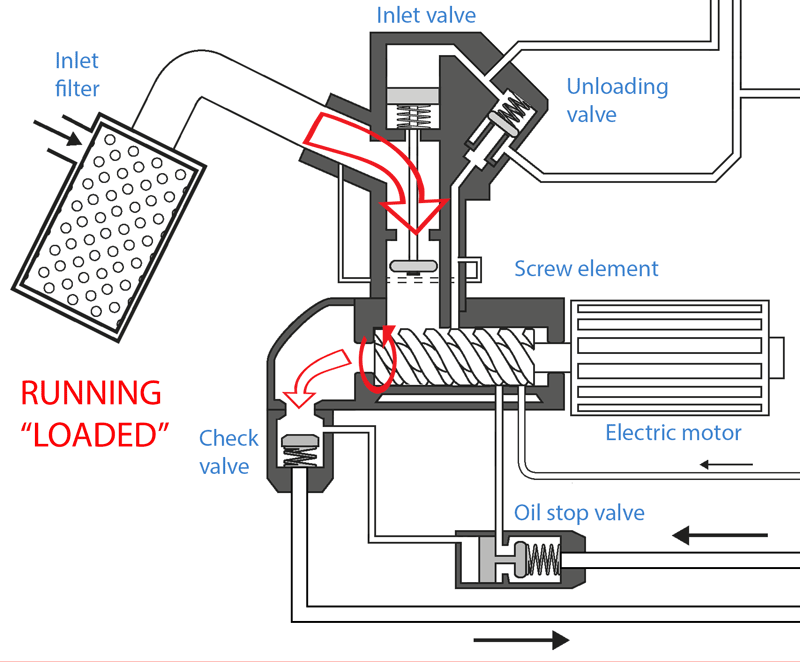 When the compressors runs loaded, it is actively pumping air, creating pressure and doing it’s job :) 1) The inlet valve is open, so air can be sucked in. * The screw element (air-end) is turning. Sucking air in and outputting an air-oil mixture. * The check valve after the screw element is open, because the screw element is compressing air and there’s a continues flow of air/oil mixture through the outlet. * The oil-stop-valve is open, because pressure from the screw outlet pushes it open The pressure in the separator vessel is close to working pressure, around 7 – 8 bar in a typical compressed air system. All good! ## Compressor runs unloaded
When the compressors runs loaded, it is actively pumping air, creating pressure and doing it’s job :) 1) The inlet valve is open, so air can be sucked in. * The screw element (air-end) is turning. Sucking air in and outputting an air-oil mixture. * The check valve after the screw element is open, because the screw element is compressing air and there’s a continues flow of air/oil mixture through the outlet. * The oil-stop-valve is open, because pressure from the screw outlet pushes it open The pressure in the separator vessel is close to working pressure, around 7 – 8 bar in a typical compressed air system. All good! ## Compressor runs unloaded
 When the compressor runs unloaded, it is still running, but it is not actively pumping air or building any pressure. The inlet valve is closed, so no ‘fresh’ air can be sucked it. The screw element is turning but not taking in any new air. There is however a small amount of air drawn in to ensure proper oil flow / lubrication The outlet check valve is open because there is still a small circulation of air/oil. The oil-stop valve is open because there is still a small circulation of air/oil. The pressure in the separator vessel is at the ‘internal unload pressure’. It is typically around 2.5 – 3.5 bar. ## Compressor Stops
When the compressor runs unloaded, it is still running, but it is not actively pumping air or building any pressure. The inlet valve is closed, so no ‘fresh’ air can be sucked it. The screw element is turning but not taking in any new air. There is however a small amount of air drawn in to ensure proper oil flow / lubrication The outlet check valve is open because there is still a small circulation of air/oil. The oil-stop valve is open because there is still a small circulation of air/oil. The pressure in the separator vessel is at the ‘internal unload pressure’. It is typically around 2.5 – 3.5 bar. ## Compressor Stops
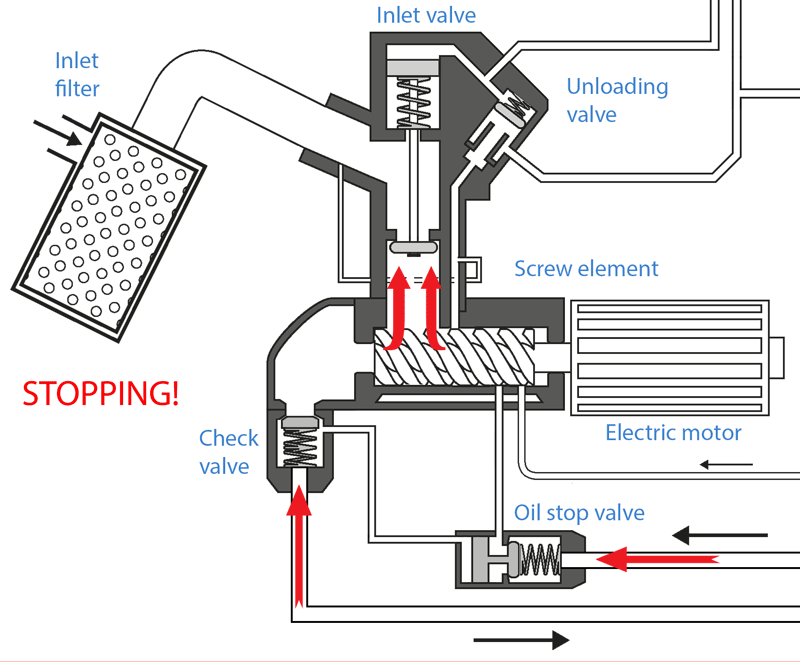 When you fully stop the compressor, the following things happen. - The inlet valve was closed already - The screw element stops turning. - The screw element outlet check valve closes - The oil-stop valve closes as the oil pressure disappears. The remaining pressure in the separator vessel is blown of through a small hole. But it takes some time. Trapped air wants to escape Meanwhile, the compressed air tries any way possible to escape the air compressor. One way is back to the screw element and out through the inlet filter. A part of the air/oil mixture will make it back past the check valve and/or the oil-stop valve. And there will be a good amount of oil in the screw element already. Since the screw element is stopped now, there’s nothing that stops the compressed air/oil mixture flowing to the inlet side of the screw element and reaching the inlet valve. There it encounters the closed inlet valve: it can’t go any further. All good – the oil stays inside. The pressure is slowly released through the blow-down valve, and we’re all happy. ## Now, back to the oil vomiting problem
When you fully stop the compressor, the following things happen. - The inlet valve was closed already - The screw element stops turning. - The screw element outlet check valve closes - The oil-stop valve closes as the oil pressure disappears. The remaining pressure in the separator vessel is blown of through a small hole. But it takes some time. Trapped air wants to escape Meanwhile, the compressed air tries any way possible to escape the air compressor. One way is back to the screw element and out through the inlet filter. A part of the air/oil mixture will make it back past the check valve and/or the oil-stop valve. And there will be a good amount of oil in the screw element already. Since the screw element is stopped now, there’s nothing that stops the compressed air/oil mixture flowing to the inlet side of the screw element and reaching the inlet valve. There it encounters the closed inlet valve: it can’t go any further. All good – the oil stays inside. The pressure is slowly released through the blow-down valve, and we’re all happy. ## Now, back to the oil vomiting problem
Let’s see when and why this happens. ### First situation: emergency stop
You know it’s wrong to use that big red button as a regular stop, right? I once had this customer with this problem we’re talking about here. He had oil leaking 'somewhere' in his compressor. He didn’t know where it came from exactly, but he always found it there on monday morning! Every Monday morning he would find some oil on the floor near his screw compressor. Magic? Little men entering the factory during the weekend and making a mess? No! Turns out, every Friday afternoon, as the factory closed for the weekend, the guys were just too happy that last shift was over… time for a beer! So they would just hit that big red button on the air compressor and call it a day. Weekend! Understandable, but wrong! Never use the emergency stop button to stop your compressor Switch to 'unloaded' first, before completely stopping the compressor. Do use the emergency stop in case of an emergency, of course. Don’t do it guys. Use the proper procedure to stop your air compressors: 1) Switch it to ‘unloaded’ (or just stop using air and wait for the compressor to unload itself) 2) Wait some time and stop the compressors When you hit the emergency stop when the compressor is running loaded, the inlet valve has no time to close so quickly. Plus, the full working pressure is in the separator vessel. That compressed air (and oil!) will find its way out back through the inlet filter as soon as the element stops turning (pretty quickly). The inlet valve was completely open and in many cases, it won’t close fast enough to stop the back flow of the oil/air mixture. 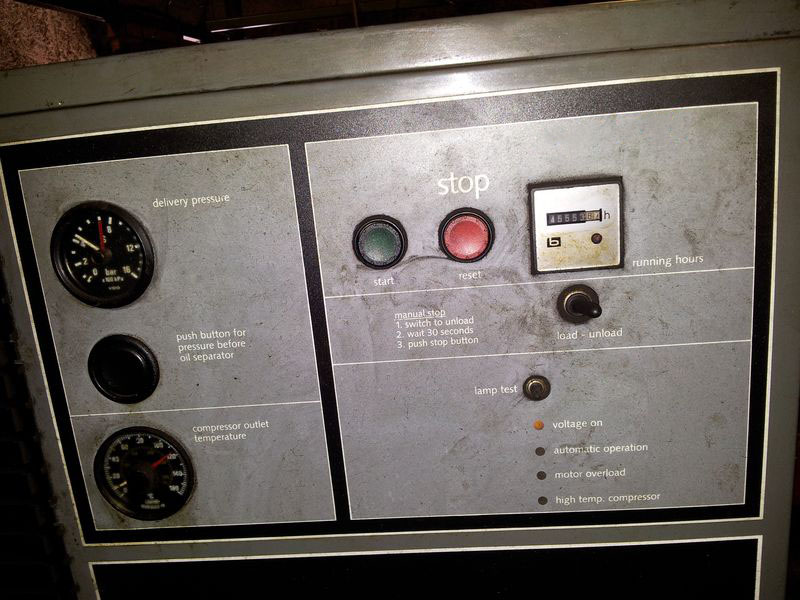 To stop the compressor, switch to 'unload' first (black switch). Only then press the red stop button### Second situation: mechanical problems
To stop the compressor, switch to 'unload' first (black switch). Only then press the red stop button### Second situation: mechanical problems
If you have this problem, and you stop the compressor the correct way, then the most common problem is that the inlet valve doesn’t close completely. So when the compressor stops, there’s a way back for the air/oil mixture! The inlet valve is a bit open, and the air/oil mixture will find it’s way back out. Simple as that.  Oil escapes back to the inlet filter if the inlet valve doesn't close completely### Troubleshooting
Oil escapes back to the inlet filter if the inlet valve doesn't close completely### Troubleshooting
If you have this problem, first make sure that the compressor is stopped using the correct procedure. Never stop a compressor with the emergency stop button! Older, less ‘smart’ compressor also allow you to simply press the ‘stop’ button (the normal stop button, not the emergency stop) and it will stop. Even when it was running loaded. Newer compressor will not allow this. Or, they will switch to ‘unloaded’ first and then stop the compressor for you. If you are sure this is not the case, your main suspect is the inlet valve. Remove it, inspect it and overhaul it if necessary. As always: be extra careful when opening a screw compressor inlet valve. They usually contain a big spring that is under tension. Open it the wrong way and it will pop open in your face. Be careful! If the inlet valve is OK. Check and overhaul the check valve at the outlet of the screw element and the oil-stop-valve. In some cases, there’s a tiny check valve close to the inlet valve, see below for more details. ## Other considerations / extra info
Here are some extra things to keep in mind and just some extra related info about this problem Electricity consumption If you have an inlet valve that stays partly open, or at the very least, is leaking, this would also have a big influence on your unloaded running state electricity consumption, as the unloaded internal pressure will rise due to this. Normally, the unload electricity consumption is 1/3 of the loaded electricity consumption. As the internal pressure rises, so will the electricity consumption. But most of the time, this isn’t noticed (and it’s hard to tell because there’s no pressure gauge to show you the unload internal pressure!) Inlet valve not closing at all / only half If the gap is too big, or if the inlet valve stays completely open, you will notice this in the fact that the compressor keeps pumping pressure. The compressor wouldn’t really ‘unload’ anymore. The problem would become “it doesn’t unload”. Oil-stop valve and check-valve As we have seen before, there are measures taken to prevent backflow of the air/oil mixture. The oil-stop valve, the check valve (after the screw element) and the main one: the inlet valve. 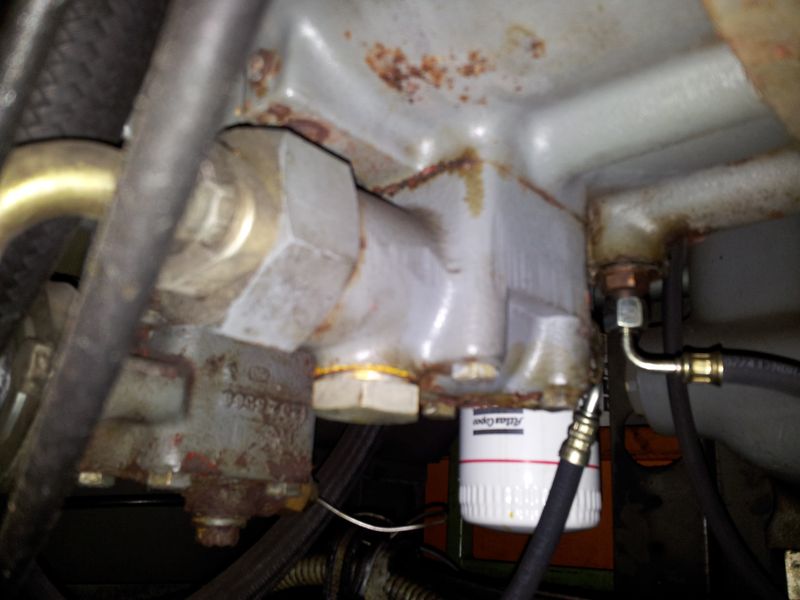 Oil stop valve (front) and check valve (in the back)
Oil stop valve (front) and check valve (in the back) 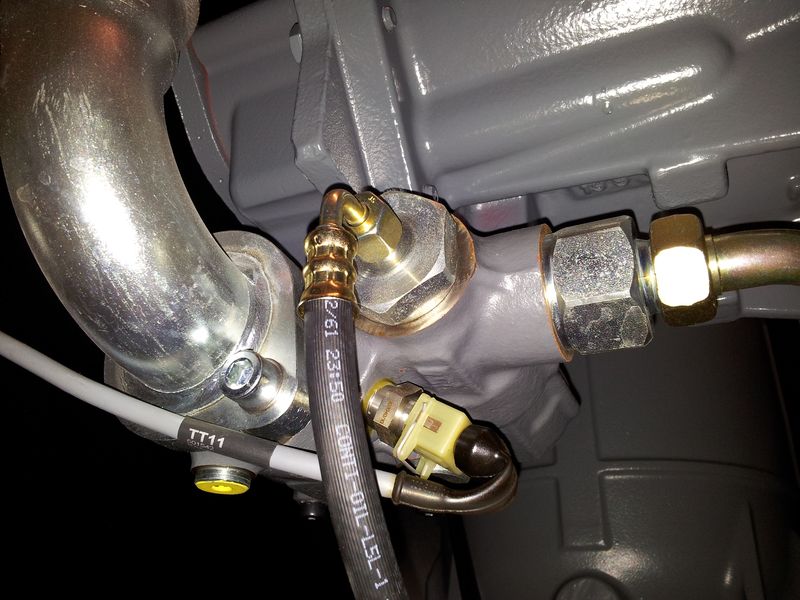 Oil stop valve (right) and check valve (left) both in a single housing Not all machines have both of these valves valves. Some machines, especially smaller machines, don’t have these two valves at all! The oil-stop valve and the screw element outlet check-valve do help to stop the back-flow of air, but their main purpose is to stop the screw element from flooding when the compressor is stopped. A flooded screw element would make it harder for the compressor to start up again. This is a bigger problem on big compressors. So you will see them more often on bigger compressors compared to smaller compressors. ‘More oil, more problems’ we could say :) ## Troubleshooting help
Oil stop valve (right) and check valve (left) both in a single housing Not all machines have both of these valves valves. Some machines, especially smaller machines, don’t have these two valves at all! The oil-stop valve and the screw element outlet check-valve do help to stop the back-flow of air, but their main purpose is to stop the screw element from flooding when the compressor is stopped. A flooded screw element would make it harder for the compressor to start up again. This is a bigger problem on big compressors. So you will see them more often on bigger compressors compared to smaller compressors. ‘More oil, more problems’ we could say :) ## Troubleshooting help
I hope this article is of help to you if you experience this problem with your air compressor. I would say 50% of the time it’s a user problem (stopping the compressor the wrong way) and 50% of the time it’s a mechanical problem: most of the time the inlet valve. If you need help troubleshooting your air compressor, please check out the troubleshooting section of this website. Or, for more in-depth help, get my Air Compressor Troubleshooting Guide.

Comments
No comments yet…
Log in or create an account to make a comment...